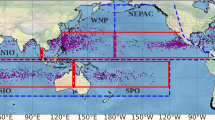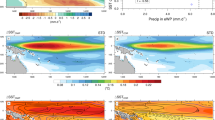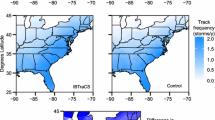Abstract
This study examines how characteristics of tropical cyclones (TCs) that are explicitly resolved in a global atmospheric model with horizontal resolution of approximately 28 km are projected to change in a warmer climate using bias-corrected sea-surface temperatures (SSTs). The impact of mitigating from RCP8.5 to RCP4.5 is explicitly considered and is compared with uncertainties arising from SST projections. We find a reduction in overall global TC activity as climate warms. This reduction is somewhat less pronounced under RCP4.5 than under RCP8.5. By contrast, the frequency of very intense TCs is projected to increase dramatically in a warmer climate, with most of the increase concentrated in the NW Pacific basin. Extremes of storm related precipitation are also projected to become more common. Reduction in the frequency of extreme precipitation events is possible through mitigation from RCP8.5 to RCP4.5. In general more detailed basin-scale projections of future TC activity are subject to large uncertainties due to uncertainties in future SSTs. In most cases these uncertainties are larger than the effects of mitigating from RCP8.5 to RCP4.5.




Similar content being viewed by others
References
Bacmeister JT et al. (2014) Exploratory high-resolution climate simulations using the community atmosphere model (CAM). J Clim 27(9):3073–3099
Bell GD, Chelliah M (2006) Leading tropical modes associated with interannual and multidecadal fluctuations in North Atlantic hurricane activity. J Clim 19(4):590–612
Camargo SJ, Sobel AH (2005) Western North Pacific tropical cyclone intensity and ENSO. J Clim 18(15):2996–3006
Dennis J et al. (2011) CAM-SE: A scalable spectral element dynamical core for the Community Atmosphere Model. International Journal of High Performance Computing Applications 26:74–89
Done JM, PaiMazumder D, Towler E et al (2015) Estimating Impacts of North Atlantic Tropical Cyclones Using an Index of Damage Potential. Clim Change. doi:10.1007/s10584-015-1513-0
Efron B, Tibshirani RJ (1998) An Introduction to the bootstrap. Monographs on Statistics and Applied Probablity 57. Chapman and Hall/CRC Press, Boca Raton FL. 435 pp.
Emanuel KA, D Nolan, 2004: Tropical cyclone activity and the global climate system. Preprints, 26th Conf. on Hurricanes and Tropical Meteorology, Miami, FL, Amer. Meteor. Soc., 10 A.2. [Available online at https://ams.confex.com/ams/26HURR/techprogram/paper_75463.htm.]
Gettelman, A., D. Bresch, C. C. Chen, et al. (2016) Projections of future tropical cyclone damage with a high resolution global climate model. Climatic Change. (in review)
Gray WM (1984) Atlantic seasonal hurricane frequency. Part I: El Nino and 30 mb quasi-biennial oscillation influences. Mon Weather Rev 112(9):1649–1668
Held IM, Soden BJ (2006) Robust responses of the hydrological cycle to global warming. J Clim 19(21):5686–5699
Hurrell JW, Hack JJ, Shea D, Caron JM, Rosinski J (2008) A new sea surface temperature and sea ice boundary dataset for the Community Atmosphere Model. J Clim 21:5145–5153. doi:10.1175/2008JCLI2292.1.
Jiang H, Zipser E (2010) Contribution of tropical cyclones to the global precipitation from eight seasons of TRMM data: Regional, seasonal, and interannual variations. J Clim 23:1526–1543
Kay J et al. (2015) The Community Earth System Model (CESM) Large Ensemble Project: A Community Resource for Studying Climate Change in the Presence of Internal Climate Variability. Bull. Amer. Meteorol. Soc. doi:10.1175/BAMS-D-13-00255.1
Knapp KM et al. (2010) The International Best Track Archive for Climate Stewardship (IBTrACS): Unifying tropical cyclone data. BAMS 91:363–376
Knutson TR, McBride JL, Chan J, Emanuel K, Holland G, Landsea C, Held I, Kossin JP, Srivastava AK, Sugi M (2010) Tropical cyclones and climate change. Nat Geosci 3(3):157–163
Knutson TR et al. (2015) Global Projections of Intense Tropical Cyclone Activity for the Late Twenty-First Century from Dynamical Downscaling of CMIP5/RCP4.5 Scenarios. J Clim 28(18). doi:10.1175/JCLI-D-15-0129.1
Manganello JV et al. (2012) Tropical cyclone climatology in a 10-km global atmospheric GCM: toward weather-resolving climate modeling. J Clim 25(11):3867–3893
Murakami H, Mizuta R, Shindo E (2012a) Future changes in tropical cyclone activity projected by multi-physics and multi-SST ensemble experiments using the 60-km-mesh MRI-AGCM. Clim Dyn 39(9–10):2569–2584
Murakami H et al. (2012b) Future changes in tropical cyclone activity projected by the new high-resolution MRI-AGCM. J Clim 25:3237–3260
Murakami H, Hsu P-C, Arakawa O, Li T (2014) Influence of model biases on projected future changes in tropical cyclone frequency of occurrence. J Clim 27:2159–2181
Neale, R. J. et al. (2012) Description of the NCAR Community Atmosphere Model (CAM 5.0). NCAR Tech. Note NCARTN-4861STR, 274 pp
O’Gorman PA, Schneider T (2009) The physical basis for increases in precipitation extremes in simulations of 21st-century climate change. Proc Natl Acad Sci 106(35):14773–14777
Pielke Jr RA, Landsea CN (1999) La nina, el nino and atlantic hurricane damages in the united states. Bull Am Meteorol Soc 80(10):2027–2033
Reed KA, Bacmeister JT, Rosenbloom N et al. (2015) Impact of the dynamical core on the direct simulation of tropical cyclones in a high-resolution global model. Geophys Res Lett 42(9):3603–3608
Small RJ et al. (2014) A new synoptic scale resolving global climate simulation using the Community Earth System Model. Journal of Advances in Modeling Earth Systems 6(4):1065–1094
VanVuuren DP et al. (2011) Representative concentration pathways: an overview. Clim Chang 109:1–2 5–31
Villarini G et al. (2014) Sensitivity of tropical cyclone rainfall to idealized global-scale forcings. J Clim 20(12):2307–2314
Walsh KJ et al. (2015) Hurricanes and climate: the US CLIVAR working group on hurricanes. Bull Am Meteorol Soc 96:997–1017. doi:10.1175/BAMS-D-13-00242.1
Wang C, Zhang L, Lee SK, Wu L, Mechoso CR (2014) A global perspective on CMIP5 climate model biases. Nat Clim Chang 4(3):201–205
Wehner M et al. (2015) Resolution dependence of future tropical cyclone projections of CAM5. 1 in the US CLIVAR Hurricane Working Group idealized configurations. J Clim 28(10):3905–3925
Zhao M, Held IM (2012) TC-permitting GCM simulations of hurricane frequency response to sea surface temperature anomalies projected for the late-twenty-first century. J Clim 25(8):2995–3009
Zhao M, Held IM, Lin SJ, Vecchi GA (2009) Simulations of global hurricane climatology, interannual variability, and response to global warming using a 50-km resolution GCM. J Clim 22(24):6653–6678
Zhao M, Held IM, Lin S-J (2012) Some counter-intuitive dependencies of tropical cyclone frequency on parameters in a GCM. J Atmos Sci 69(7). doi:10.1175/JAS-D-11-0238.
Acknowledgments
Computing resources for this work were provided by; The Argonne Leadership Computing Facility at Argonne National Laboratory (Office of Science of the US Department of Energy) through the Innovative and Novel Computational Impact on Theory and Experiment (INCITE) program, and the Climate Simulation Laboratory at NCAR’s Computational and Information Systems Laboratory, sponsored by the National Science Foundation and other agencies. This work also utilized part of the “Using Petascale Computing Capabilities to Address Climate Change Uncertainties” PRAC allocation support by the National Science Foundation (NSF), and the Blue Waters sustained-petascale computing project supported by the NSF and the state of Illinois.
The authors would also like to acknowledge support from the Regional and Global Climate Modeling Program (RGCM) of the US Department of Energy, Office of Science (BER), Cooperative Agreement DE-FC02-97ER62402 and from NSF’s EaSM program.
Author information
Authors and Affiliations
Corresponding author
Additional information
This article is part of a Special Issue on “Benefits of Reduced Anthropogenic Climate ChangE (BRACE)” edited by Brian O’Neill and Andrew Gettelman.
Electronic supplementary material
ESM 1
(PDF 7455 kb)
Rights and permissions
About this article
Cite this article
Bacmeister, J.T., Reed, K.A., Hannay, C. et al. Projected changes in tropical cyclone activity under future warming scenarios using a high-resolution climate model. Climatic Change 146, 547–560 (2018). https://doi.org/10.1007/s10584-016-1750-x
Received:
Accepted:
Published:
Issue Date:
DOI: https://doi.org/10.1007/s10584-016-1750-x




